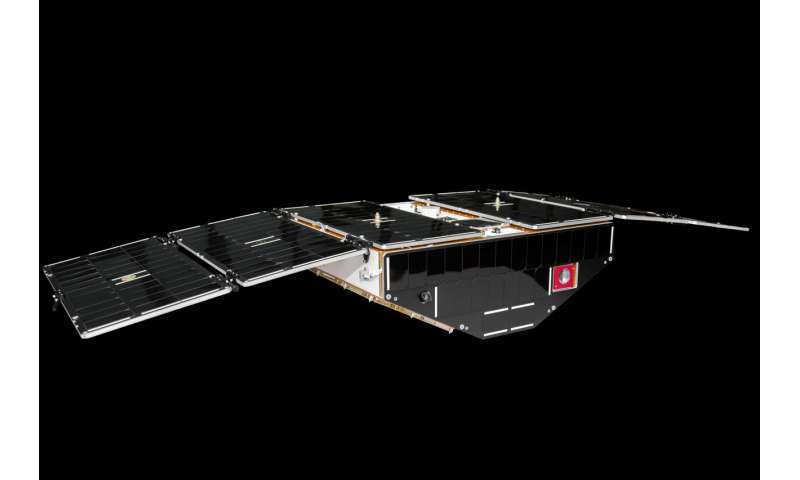Model of SwRI-built spacecraft to be displayed in Smithsonian

A model of a Cyclone Global Navigation Satellite System (CYGNSS) microsatellite has been delivered to the Smithsonian's National Air and Space Museum in Washington for an upcoming display. The CYGNSS mission is to improve tropical storm and hurricane forecasting. The constellation of eight microsatellites was designed, built and operated by Southwest Research Institute (SwRI) for the University of Michigan. The model will be a part of a permanent exhibit at the museum showing the evolution of spacecraft over several decades.
"CYGNSS was a remarkable step forward for microsatellites and Earth science," said Dr. Jim Burch, senior vice president of SwRI's Space Sector. "It's a tremendous honor that this model will hang among the greats in the aerospace field, in the National Air and Space Museum, educating and inspiring generations. It's a testament to the significant ingenuity, skill and personal dedication demonstrated by the CYGNSS team."
The CYGNSS model will be displayed in the museum's upcoming "RTX Living in the Space Age" exhibition, which will provide insight into space hardware and infrastructure that are largely invisible to the public but have a profound impact on their daily lives Some of the key artifacts will include the Hubble Space Telescope, Skylab Orbital Workshop, Standard Missile-3 and several generations of EVA (extravehicular activity) spacesuits
"The development of the CYGNSS satellite is an important part of the story of the role that space age technology plays in our day-to-day lives of predicting weather," said Cathleen Lewis, space history curator at the National Air and Space Museum. "Prior to CYGNSS, the only way to measure wind speed within a storm was the hazardous mission of flying an airplane into the storm. We look forward to sharing this story in the 'Living in the Space Age' exhibition."
Each of the eight CYGNSS microsatellites are roughly the size of a piece of carry-on luggage and are designed to make frequent measurements of ocean surface winds and monitor the location, intensity, size and development of tropical cyclones. Flying in formation, the spacecraft cover an orbital swath that passes over most of the Earth's hurricane-producing zone—35 degrees north and south of the Equator.
"CYGNSS was NASA's first small satellite science mission, setting the stage for what we see today in the small satellite industry by providing key funding and innovative technology development," said Institute Engineer Randy Rose, the project systems engineer for CYGNSS and technical lead for SwRI's smallsat program. "The data CYGNSS provides has significantly improved hurricane forecasting, allowing scientists to track storms and their intensification more accurately. Additionally, the CYGNSS science team discovered that the sensor technology used by the CYGNSS observatories is an excellent means to detect wetland water extents, soil moisture and other key aspects of land-based water."
Since launching in 2016, CYGNSS has made history, penetrating thick clouds and heavy rains to accurately assess wind speeds and better understand hurricane intensification. CYGNSS gathers data on storms between several times a day and monitors their development and capturing sudden changes like rapid intensification greatly enhancing storm predictions. In 2020, NASA deemed the satellites healthy and extended the mission into 2026.
SwRI assembled the model from leftover spare parts from the original CYGNSS spacecraft and engineering model components. The model represents the external structural skeleton of the microsatellite.
The model will be on display to the public following ongoing museum renovations.
Provided by Southwest Research Institute